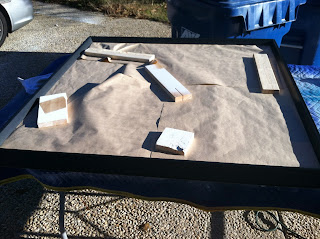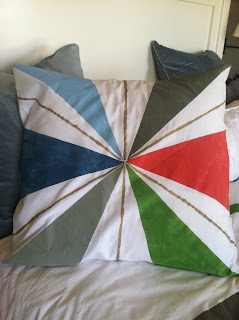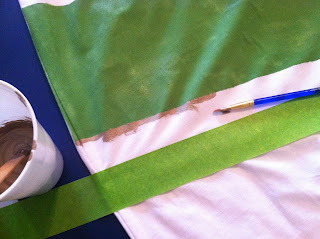If you haven't noticed, I'm kinda re-doing my Master bedroom (or maybe doing it in the first place?), one piece at a time. I made a bed, and some bedding to go with it. My husband said, "we really need something on that wall." I agreed, it was always in the plan...but once he pointed it out, I really wanted something there. And then I got an idea, and I couldn't stop until my idea was complete.
I had this picture above my bed a couple of houses ago, and it's a big one--about 40" x 40". I really liked the picture and it went with my paint and bedding, but it no longer worked with my color scheme.
The picture has been sitting behind a sofa in my bedroom since we moved in. I thought, "the space is big on the wall, the picture is big, why don't I reuse that picture somehow?". I know, pure genius in action. ;-)
I removed the backing from the picture. It was a really nice professionally-done framing job, which meant dust protection on the back and lots and lots of staples.
But what to put in the frame? I had been toying around with using the title from "our song": It's "Friday I'm in Love, by the Cure". I know that dates us, now you know how old we are.
Also I pinned the back of this chair on Pinterest, the gradation of color has always fascinated me:
I knew I wanted to do something like that for a project, and here was a project needing something so, BAM! Match made in project heaven.
First I went to the craft store and bought a bunch of square scrapbook paper in the colors I wanted to use. I also happened to buy another craft punch (love these!) in the shape of a 2" circle. All of these things were 50% off so my grand total investment was $20.
It took me about an hour to punch out all of the circles, which my 4-year-old daughter put in little piles for me. She loves to be my assistant.
I started randomly lining up the circles on foam board, starting with darker colors at the bottom.
I decided pretty quickly that although I liked the colors, I didn't like all the white in the background. So I started to experiment with squishing the circles together.
I discovered a pattern that I liked; kind of like a cloverleaf where one side of each circle overlaps the next side. I then taped the back of each cloverleaf.
I could tell this project was getting to complicated for the floor, so back to the ping pong table!
I continued to line the colors up to the top, going back and making my little clovers and taping them on the back until I was finished.
I then started gluing the clovers to the board with a glue stick; starting with the bottom row and side row to get the spacing right. I overlapped the clovers the same way as each clover, so that every row the circles went on top of each other the same way.
Until I was all done!
I purchased some letters in vinyl from an online retailer, the capitals being 4" high. I placed them on the paper, and I was a little nervous that the vinyl would tear the paper circles, but it stuck beautifully.
Now to deal with the black frame. I wanted it white. So, out comes my beloved spray paint! Whenever I spray paint a frame that was custom framed I always leave the glass in. This is because if you are lucky enough to get the glass out of the frame without breaking it, you will probably break it when you try and get it back in. Trust me, I've broken my fair share of glass.
So when you set up the frame (with glass) to spray paint, you have to support the glass off of the surface you are spray painting. I used scrap 4 x 4 and 2 x 4 pieces of wood. The frame will hang on the glass.
I used roll of painter's paper and carefully slipped the paper between the glass and the frame. I secured the paper to the glass by using more scrap wood as weight.
I lightly sanded all the way around and inside the frame so that the paint would adhere better to the frame.
It only took a few light coats and of glossy white paint and about 20 minutes to turn this black frame white.
I reassembled the frame with the glass, mat board, and my paper creation. When I went to get the cardboard backing, I found this artwork:
If I leave any large open surface in my house for any amount of time, my assistant adds her special touches to my project. Here is the final piece hung on the wall of my bedroom:
I do love this new piece, and I smile when I look at it every day. Sometimes I sing these totally appropriate lyrics of one of my favorite songs:
"Monday, you can hold your head
Tuesday, Wednesday stay in bedOr Thursday watch the walls instead
It's Friday I'm in love"
So now I have something to watch on the walls, from my bed. While holding my head. And not just on Fridays!


































































